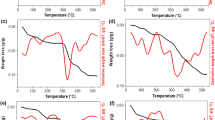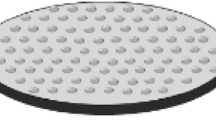Abstract
In this review, the regularities of formation, structure and high reactivity of two types of energetic metal/solid oxidizer nanocomposites (Al(Mg)/X (X = MoO3, (–C2F4–) n )) prepared by mechanoactivation are examined. One reason for the high reactivity is an increase in contact surface between the components occurring after mechanoactivation. Two methods for determination of area of contact surface S C between the components are used, and the values of S C for all the systems are estimated. Considerable attention is paid to the role of highly reactive defects (grain sizes, dislocations and stacking faults, paramagnetic centers, “weakly bound” oxygen in MoO3, etc.), formed in the components under mechanical stress. For the Me/MeO3 systems, the formation of point defects in the oxide is an important factor. It was found that, after mechanoactivation, the evolution of O2 from MoO3 occurs at 230–450 °C. It is argued that this process is associated with the thermal destruction of “weak” Mo–O bonds in the “bridge” oxygen. It was suggested that the formation of defect structure in MoO3 and increasing of the oxygen mobility under heating give rise to a low-temperature peak in DSC curves and initiated self-ignition on the fuel–air mixture. For composites Mg/MoO3, self-ignition occurs at temperature 100 °C lower than that for Al/MoO3: The decreasing of temperature can be connected with larger S C in the first system. In the Mg/(–C2F4–) n system, the reactions of magnesium defects with (–C2F4–) n are accompanied by a weak heat evolution, too low to initiate ignition. In this case, the reaction is initiated by the thermal depolymerization of (–C2F4–) n , while a high values of S C provide a complete conversion. In the case of shock-wave initiation, defects in the components play only a minor role in the conversion, whereas the value of S C remains to be highly important.

















Similar content being viewed by others
References
Dreizin EL (2009) Metal-Based Reactive Nanomaterials. Prog Energy Combust Sci 35:141–167
Dixon GP, Martin JA, Thompson D (1998) Lead-free precussion primer mixes based on metastable interstitial composite (MIC) Technology, US Patent No. 5717159
Son SF, Busse JR, Asay BW, Peterson PD, Mang JT, Bockmon B, Pantoya ML (2002) Propagation studies of metastable intermolecular composites (MIC), in Twenty-Ninth International Pyrotechnics Seminar, Ed. by F. J. Schelling (IPS USA, Westminster), 203–212
Kolbanev IV, Butyagin PYu, Streletskii AN (2000) On the mechanochemistry of aluminum. Khim Fiz 19:96
Dolgoborodov AYu, Gogulya MF, Brazhnikov MA, Makhov MN, Fortov VE (2002) Detonation- like phenomena in Al/S Mixture, in Twenty-Ninth Int.Pyrotech. Seminar, Ed. by F. J. Schelling (IPS USA, Westminster, 2002), pp 557–563
Dolgoborodov AYu, Makhov MN, Gogulya MF, Streletskii AN, Kolbanev IV, Fortov VE (2003) Effect of Mechanical Activation on the Detonability of Oxidizer–Fuel Mixtures,” in V. E. Substances, Materials, and Structures under Intense Dynamic Loads, Ed. By A. L. Mikhailov (VNIIEF, Sarov, 2003), 273–278 [in Russian]
Suryanarayana C (2001) Mechanical alloying and milling. Prog Mater Sci 46:1–184
Grigor’eva TF, Barinova AP, Lyakhov NZ (2003) Mechanosynthesis of nanocomposites. J Nanoparticles Res 5:439–453
Grigor’eva TF, Korchagin MA, Barinova AP et al (1999) Influence of the mechanochemical activation on concentration limits of self- propagating high- temperature synthesis. Dokladi Akademii Nauk 369:345–347
Karagedov GR, Laykhov NZ (1997) Effect of mechanical activation on sintering of alumina. Inrganic Mater 33:688–691
Streletskii AN, Kolbanev IV, Borunova AB, Butyagin PYu (2004) Mechanochemically activated aluminium: preparation, structure and chemical properties. J Mater Sci 39:5175–5179
Pivkina A, Streletskii A, Kolbanev I, Ul’yanova P, Frolov Yu, Butyagin Yu, Schoonman J (2004) Mechanochemically activated nano-aluminium: oxidation behaviour. J Mater Sci 39:5451–5453
Streletskii AN, Kolbanev IV, Borunova AB, Yu Butyagin P (2005) Mechanochemical activation of aluminum: 3. Kinetics of interaction of Al with water. Colloid J 67:631–637
Streletskii AN, Mudretsova SN, Povstugar IV, Yu Butyagin P (2006) Mechanochemical activation of aluminum: 5. Formation of aluminum carbide upon heating of activated mixtures. Colloid J 68:623–631
Streletskii AN, Kolbanev IV, Borunova AB, Butyagin PYu (2010) Formation Mechanisms, Structure and Reactivity of “Mechanochemical” Nanocomposites”—In Experimental and Theoretical Studies in Modern Mechanochemistry, Ed. F. Delogu and G. Mulas, Transworld Research Network 37/661(2) Fort P.O. Kerala, India, pp. 169–189
Dolgoborodov AYu, Makhov MN, Kolbanev IV, Streletskii AN (2004). mechanically activated pyrotechnic composition, RF Patent No. 2235085, Buyl. Izobr. No. 24
Dolgoborodov AYu, Makhov MN, Streletskii AN, Kolbanev IV, Gogulya MF, Fortov VE (2004) On the possibility of detonation in a mechanically activated aluminum-polytetrafluoroethylene composite. Khim Fiz 23(9):85–88
Dolgoborodov AYu, Makhov MN, Kolbanev IV, Streletskii AN, Fortov VE (2005) Detonation in an aluminum-teflon mixture. JETP Lett 81:311–314
Dreizin EL, Schoenitz M (2009) Nano-composite energetic powders prepared by arrested reactive milling, US Patent No. 7524355 B2
Umbrajkar SM, Schoenitz M, Dreizin EL (2006) Control of structural refinement and composition in Al-MoO3 nanocomposites prepared by arrested reactive milling. Propellants Explos Pyrotech 31:282–289
Williams RA, Schoenitz M, Ermoline A, Dreizin EL (2014) Low-temperature exothermic reactions in fully-dense Al/MoO3 nanocomposite powders. Thermochim Acta 594:1–10
Sun J, Pantoya ML, Simona SL (2006) Dependence of size and size distribution on reactivity of aluminum nanoparticles in reactions with oxygen and MoO3. Thermochim Acta 444:117–127
Schoenitz M, Umbrajkar S, Dreizin EL (2007) Kinetics analysis of thermite reactions in Al-MoO3 nanocomposites”. J Propul Power 23:683–687
Dolgoborodov AYu, Streletskii AN, Makhov MN, Teselkin VA, Guseinov ShL, Storozhenko PA, Fortov VE (2012) Promising energetic materials composed of nanosilicon and solid oxidizers. Russ J Phys Chem B6:523–530
Dolgoborodov AYu, Ermolaev BS, Shevchenko AA, Teselkin VA, Kirilenko VG, Monogarov KA, Streletskii AN (2015) Combustion and detonation of mechanoactivated aluminum-potassium perchlorate mixtures. Russ J Phys Chem B 9:615–624
Peter Baláž, Marcela Achimovičová, Matej Baláž et al (2013) Hallmarks of mechanochemistry: from nanoparticles to technology. Chem Soc Rev 42:7571–7637
Dolgoborodov AYu (2015) Mechanically activated oxidizer-fuel energetic composites. Combus Explos Shock Waves 51:86–99
Dreizin EL, Schoenitz V (2015) Correlating ignition mechanisms of aluminum- based reactive materials with thermoanalytical measurements. Prog Energy Combust Sci 50:81–105
Rogachev AS, Mukasyan AS (2010) Combustion of heterogeneous nanostructural systems combustion. Explos Shock Waves 4:243–266
Energetic Nanomaterials: Characterization and Application. (2016) Ed. By Zarko V, 1st Edition, ISBN; 9780128027103, Elsevier
Troshin K Ya, Streletskii AN, Kolbanev IV, Borisov AA, Frolov SM, Frolov FS (2016) Promotion of the self-ignition of fuel-air mixtures with mechanoactivated Al(Mg)–MoO3. Russ J Phys Chem B10:435–443
Sterletskii AN, Dolgoborodov AYu, Kolbanev IV, Makhov MN, Lomaeva SF, Borunova AB, Fortov VE (2009) Structure of mechanically activated high-energy al + polytetrafluoroethylene nanocomposites. Colloid J 71:852–860
Streletskii AN, Kolbanev IV, Teselkin VA, Leonov AV, Mudretsova SN, Sivak MV, Dolgoborodov AYu (2015) Defective structure, plastic properties, and reactivity of mechanically activated magnesium. Rus J Phys Chem B9:148–156
Streletskii AN, Kolbanev IV, Leonov AV, Dolgoborodov AY, Vorobeva GA, Sivak MV, Permenov DG (2015) Defective structure and reactivity of mechanoactivated magnesium/fluoroplastic energy generating composites. Colloid J 77:213–225
Streletskii AN, Kolbanev IV, Ya Troshin K, Borisov AA, Leonov AV, Mudretsova SN, Artemov VV, Dolgoborodov AYu (2016) Structure and reactivity of mechanoactivated Mg(Al)/MoO3 nanocomposites. Russ J Phys Chem B 10:707–718
Sivak MV, Streletskii AN, Kolbanev IV, Leonov AV, Degtyarev EN, Permenov DG (2015) Defect structure of nanosized mechanically activated MoO3. Colloid J 77:333–340
Sivak MV, Streletskii AN, Kolbanev IV, Leonov AV, Degtyarev EN (2016) Thermal Relaxation of defects in nanosized mechanically activated MoO3. Colloid J 78:674–684
Streletskii AN (1993) Measurements and calculation of main parameters of power mechanical treatment in different mills. In: Proceedings of the 2nd International Conference on Structural Application of Mechanical Alloying. Vancouver, Canada, 20–22 sept. 1993. Ed. JJde Barbadillo, F H Froes, and R Schwarz, ASM International, Materials Park, Ohio, 44073-0002 P 51-58
Zakrevskiy VA, Tomashevskiy EE, Baptizmanskiy VV (1970) Visokolomecularnie soeginenija 12B:419 (in Russian)
Papakondylis A, Sautet P (1996) Ab Initio Study of the Structure of the α-MoO3 Solid and Study of the Adsorption of H2O and CO Molecules on Its (100) Surface. J Phys Chem 100:10681–10688
Py MA, Schmid PhE, Vallin JT (1977) Raman scattering and structural properties of MoO3. Il Nuovo Cimento 38:271–279
Mestl G, Srinivasan TKK, Knozinger H (1995) Mechanically Activated Moo3. 3. Characterization by vibrational spectroscopy. Langmuir 11:3035–3804
Mestl G, Verbruggen NFD, Knozinger H (1995) Mechanically activated MoO3. 2 Characterization of defect structures. Langmuir 11:3035–3041
Mestl G, Verbruggen NFD, Bosch E, Knozinger H (1996) Mechanically Activated MoO3. 5. Redox behavior. Langmuir 12:2961–2968
Dyrek K, Labanowska M (1991) Electron paramagnetic resonance investigation of the paramagnetic centres in polycrystalline MoO3. J Chem Soc Faraday Trans 87:1003–1009
Gurvich LV, Karachentsev GV, Kondrat’ev VN, Lebedev YuA, Medvedev VA, Potapov VK, Khodeev YuS, Energiya razryva khimicheskikhsvyazei. Potentsialy ionizatsii i srodstvo k elektronu (Energy of Chemical Bond Scission. Ionization Potentials and Electron Affinity), Moscow: Nauka, 1974
Williams RA, Shoenitz M, Ermoline A, Dreizin EL (2012) On gas release by thermally–initiated fully dense 2Al-3CuO nanocomposite powder. Int J Energ Mater Chem Propuls 11:275–292
Sullivan KT, Piekiel NW, Chowdhury S, Wu C, Zachariah MR, Johnson CE (2011) Ignition and combustion characteristic of nanoscale Al/AgIO3: a potential energetic biocidal system. Combust Sci Technol 183:285–302
Acknowledgements
This work was supported by the Russian Foundation for Basic Research (Project Nos. 16–03–00178a and 16–29–01030a) and the Program 14P of the Presidium of the Russian Academy of Sciences. The authors are grateful to V.V. Artemov and S.N. Lomaeva for providing unpublished microscopic data and center of magnet radio frequency spectroscopy of IBChPh RAS and E.N. Degtyarev for ESR measurements.
Author information
Authors and Affiliations
Corresponding author
Rights and permissions
About this article
Cite this article
Streletskii, A.N., Sivak, M.V. & Dolgoborodov, A.Y. Nature of high reactivity of metal/solid oxidizer nanocomposites prepared by mechanoactivation: a review. J Mater Sci 52, 11810–11825 (2017). https://doi.org/10.1007/s10853-017-1277-1
Received:
Accepted:
Published:
Issue Date:
DOI: https://doi.org/10.1007/s10853-017-1277-1




